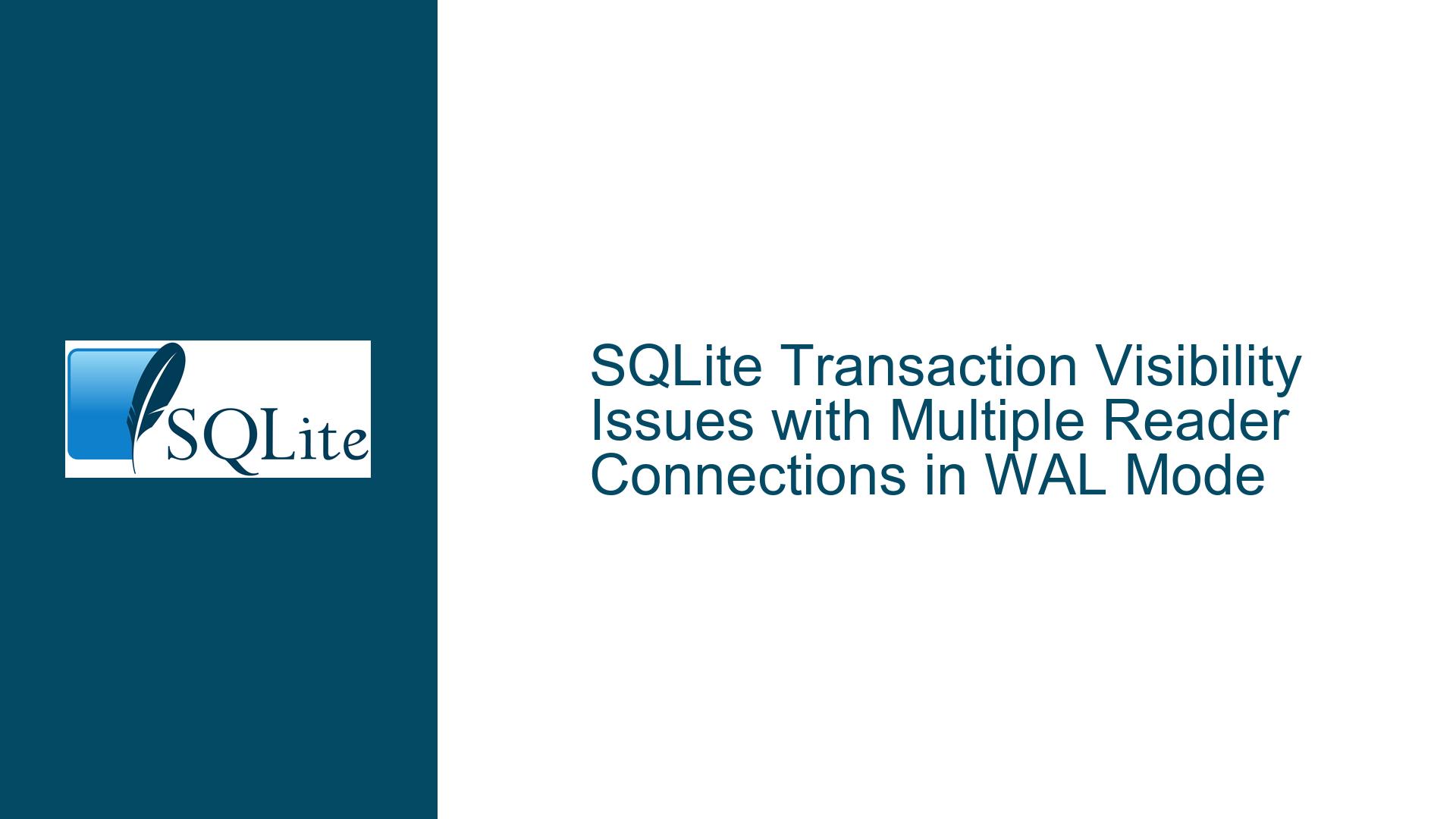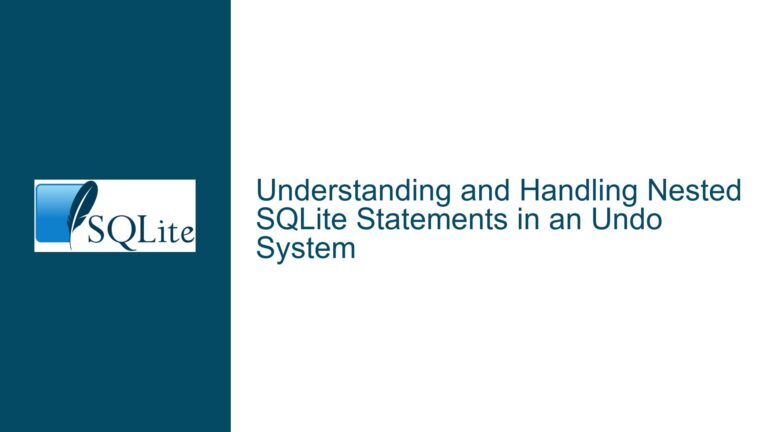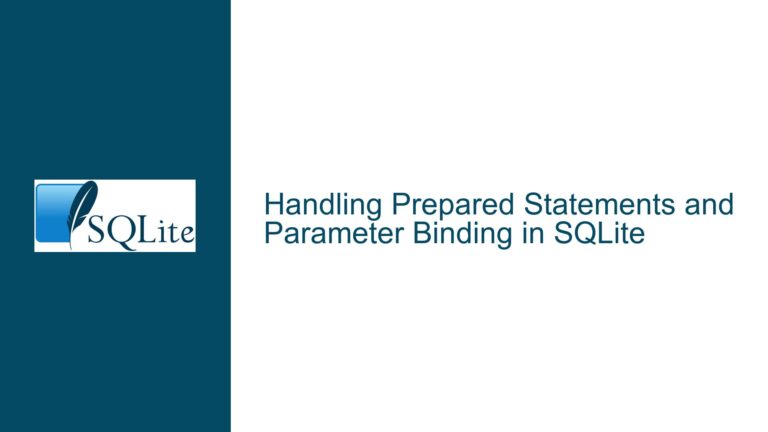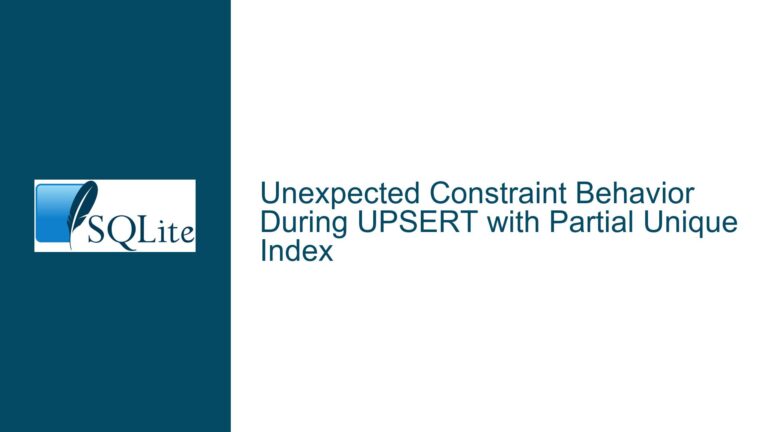SQLite Transaction Visibility Issues with Multiple Reader Connections in WAL Mode
Transaction Commit Visibility Across Multiple Reader Connections in WAL Mode
In SQLite, the Write-Ahead Logging (WAL) mode is designed to provide concurrent read and write operations, allowing readers to access the database while a writer is actively modifying it. However, ensuring that all reader connections see the latest committed changes from a writer connection can be challenging, especially when multiple reader connections are involved. The core issue arises when reader connections occasionally see an outdated version of the database, even after a writer connection has successfully committed a transaction. This behavior is particularly noticeable when the number of reader connections increases, leading to inconsistencies in the data visible to different readers.
The WAL mode in SQLite operates by maintaining a separate log file (the WAL file) that records all changes made to the database. When a writer commits a transaction, the changes are appended to the WAL file, and the database file itself is not immediately modified. Reader connections can then read from the database file and the WAL file to get a consistent view of the database at the time their read transaction began. However, this mechanism relies on the reader connections starting a new transaction after the writer has committed its changes. If a reader connection does not start a new transaction, it will continue to see the database state as it was at the time its current transaction began.
In the scenario described, the writer connection successfully commits a transaction and notifies the reader connections via Go channels. The reader connections are expected to start a new transaction immediately after receiving the notification, ensuring that they see the latest changes. However, the observed behavior suggests that some reader connections are not starting a new transaction as expected, leading to them seeing an outdated version of the database. This issue is exacerbated when the number of reader connections increases, as the likelihood of some connections not starting a new transaction in a timely manner increases.
Private Cache and Transaction Isolation in SQLite
One of the key factors contributing to the visibility issue is the use of private caches for each reader connection. In SQLite, each connection can have its own private cache, which stores recently accessed database pages. When a reader connection starts a new transaction, it checks the data version to determine if its cache is stale. If the cache is stale, it is discarded, and the connection fetches the latest data from the database file and the WAL file. However, if the reader connection does not start a new transaction, it will continue to use its cached data, which may be outdated.
The use of private caches can lead to inconsistencies when multiple reader connections are involved. Each connection’s cache is independent, and there is no mechanism for automatically invalidating the caches of all reader connections when a writer commits a transaction. As a result, some reader connections may continue to use their cached data, while others may fetch the latest data from the database. This can lead to some readers seeing the latest changes, while others see an outdated version of the database.
Another factor to consider is the isolation level of the reader connections. By default, SQLite uses the "Serializable" isolation level, which ensures that each transaction sees a consistent view of the database. However, this isolation level can lead to serialization of read queries, especially when multiple reader connections are involved. To alleviate this, SQLite provides the "Read-Uncommitted" isolation mode, which allows reader connections to see uncommitted changes made by other connections. However, this mode can lead to dirty reads, where a reader connection sees changes that have not yet been committed and may be rolled back.
In the scenario described, the reader connections are using private caches and are not explicitly setting the isolation level. This can lead to inconsistencies in the data visible to different readers, especially when the number of reader connections increases. The use of private caches and the default isolation level can also lead to performance issues, as each reader connection must check the data version and potentially discard its cache when starting a new transaction.
Implementing PRAGMA journal_mode and Database Backup Strategies
To address the visibility issue and ensure that all reader connections see the latest committed changes, several strategies can be employed. One approach is to use the PRAGMA journal_mode command to configure the journaling mode of the database. In WAL mode, the PRAGMA journal_mode=WAL command can be used to enable the Write-Ahead Logging mode, which provides better concurrency and performance compared to the default rollback journal mode. However, as discussed earlier, WAL mode can lead to visibility issues when multiple reader connections are involved.
To mitigate these issues, the PRAGMA journal_mode command can be used in conjunction with other strategies, such as forcing reader connections to start a new transaction after a writer commits its changes. This can be achieved by explicitly calling the BEGIN and COMMIT commands in the reader connections, ensuring that they start a new transaction and see the latest changes. Additionally, the sqlite3_db_cacheflush() function can be used to flush the cache of a connection, ensuring that it fetches the latest data from the database.
Another strategy is to use the PRAGMA read_uncommitted command to set the isolation level of the reader connections to "Read-Uncommitted". This allows reader connections to see uncommitted changes made by other connections, reducing the likelihood of them seeing an outdated version of the database. However, this approach should be used with caution, as it can lead to dirty reads and other consistency issues.
In addition to these strategies, it is important to ensure that the Go database wrapper is correctly handling transactions. The Go database wrapper may be "thick" and introduce additional layers of abstraction, which can lead to issues with transaction management. It is important to ensure that the wrapper is correctly starting and committing transactions, and that it is not introducing any delays or inconsistencies in the process.
Finally, it is important to implement a robust database backup strategy to ensure that the database can be recovered in the event of a failure. SQLite provides several backup options, including the sqlite3_backup_init() function, which can be used to create a backup of the database while it is still in use. This function can be used to create a backup of the database to a separate file, which can then be used to restore the database in the event of a failure.
In conclusion, ensuring that all reader connections see the latest committed changes in SQLite requires careful management of transactions, caches, and isolation levels. By using the PRAGMA journal_mode command, forcing reader connections to start new transactions, and implementing a robust backup strategy, it is possible to mitigate the visibility issues and ensure that all connections see a consistent view of the database.






